After an almost-perfect visit to Indianapolis for Thanksiving, we returned to Key West late on November 27. We were scheduled to be hauled out for some Irma repairs and some other modifications to Smartini (we just can’t leave well enough alone!) one week later, on December 4, in Riviera Beach, on Florida’s East Coast. When we came from Riviera Beach to Key West in August, it was done over three days: Riviera Beach to Miami (12 hours exactly), then Miami to Marathon (another 12 hours), and after staying in Marathon for a few weeks, Marathon to Key West (10 hours). We would have liked to be as leisurely on the way back north, but the weatherman said “Nope!”.
The forecast was for wind – and more important, waves – that would far exceed our comfort level for the entire week, except for about a 24 hour period starting Wednesday morning. We’d been watching the forecast for several days, so this came as no surprise, and we had already started to ready ourselves mentally for doing the whole trip in one shot, which would obviously include going all night Wednesday night.
People do overnight ocean passages all the time. Most sailboaters can’t make it from Florida to the Bahamas – even the shortest hops – in the light of a single day, so they often go overnight to arrive at their destination during daylight. We’ve been out well after dark fishing with our good friend Charlie, and it’s not been scary or weird. We’ve left for the Bahamas in the pre-dawn hours every one of our four trips to the Abacos. In short, there was no reason for us to worry about an all-night passage on Smartini – except for the fact that IT’S DARK AND SCARY ON THE OCEAN AT NIGHT AND WE’D NEVER DONE IT BEFORE AND WHAT IF SOMETHING HORRIBLE HAPPENED AND WE DIED?!?! (Spoiler alert – we didn’t die.)
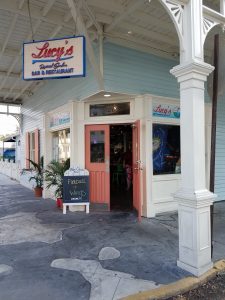
We spent the day Tuesday prepping for the trip and saying goodbye to our new friends in Key West, and planned for a Wednesday morning departure. There was no reason to start especially early, as we would be on the boat all night, regardless of when we started, and the weather wasn’t forecast to change until mid-morning on Thursday, so we got up about 6:00, ran all of our pre-departure checklists, and pulled out of the Key West Bight Marina, our home for the previous three months, about 8:15. The updated forecast was for no more than 18 knots (20.7 mph), and no more than 3.5 foot waves, with a period of 5 seconds, mostly from the north.
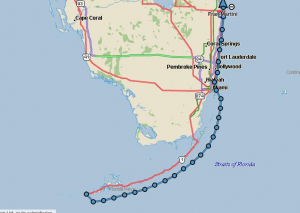
As you can see from the picture, our route started off mostly east, then curved gently to the north, as we followed the Keys. Had we been traveling during daylight hours, we would have stayed in close to shore – in the Hawk Channel, which is inside the large reef that runs offshore the length of the Keys. It’s almost always calmer in there than outside the reef. But since we’d be in the dark for much of the Keys portion of the trip, we decided we had to go “outside”, because of the lobster pots that litter the Hawk Channel. We sure as hell didn’t want to get the line of a lobster pot wrapped up in our propeller in the middle of the night, and you simply can’t see them in the dark.
Do you know about the Gulf Stream? It’s a warm and swift Atlantic ocean current that originates in the Gulf of Mexico and stretches to the tip of Florida, and follows the eastern coastlines of the United States and Newfoundland before crossing the Atlantic Ocean. It moves at 1 knot to as much as 4 knots, and is many miles wide. It accelerates as it rounds the Keys and the tip of the Florida peninsula. It’s typically a couple of degrees Fahrenheit warmer than the water immediately west of it. Surprisingly, it has a fairly sharp edge – you can be in it one minute, and a minute later, be totally out of it, when traveling perpendicular to it. If you’re crossing between Florida and the Bahamas, there’s one hard and fast rule: don’t make that crossing if there’s an “N” in the wind forecast, meaning if the wind is from the northwest, north, or northeast. The effect of the wind from the north on the current from the south is shocking. It’s hard to capture in a photograph, but I’ve seen this effect firsthand, being in 2 – 3′, short period, constantly whitecapping waves for miles and miles, and then, in the span of 30 seconds, having it flatten out to a 1′ gentle swell, as we crossed over the western edge of the stream.
But what does this have to do with our trip? We’d be only about five to seven miles offshore all day and night, following the 200 foot line (where the depth is charted at 200 feet), to make sure we were off the reef, and away from the lobster pots. Well, as it turns out, that’s far enough out to be in the stream, as we realized Wednesday afternoon, when we found ourselves in pretty blue water that was more than 2 degrees warmer than the water we had been in just an hour before.
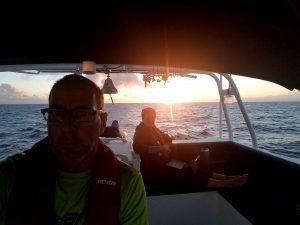
It wasn’t bad all afternoon, with the wind in the 15 – 20 knot range and the seas about 2 – 2.5 feet. A little more than we expected at that time, but not uncomfortable, with only the occasional “bell ringer”. (Smartini has a big, pretty bell up on the upper deck that will ring when we pitch a lot. Pitch is the up-and-down motion of the bow of a boat, which, of course, makes the whole boat move in a tomahawk chop motion. The only time we’ve ever experienced this was last Christmas, when we went to the Bahamas with the crew of the Turtle E. Awesome, as we were leaving the Lake Worth Inlet. It rang about a half dozen times as we powered through the almost-always-rough water just outside the inlet. Not comfortable, but it lasted only about 10 minutes before it smoothed out for the rest of the trip.)

About three hours into the trip, in full daylight and comfortable conditions, we noticed that our dinghy, which rides up on the back of the upper deck, was waggling from side to side with the waves. It’s supposed to be immobile, and always has been, so I investigated and found that one of the four mounting pads that the dinghy sits on had detached from the deck. They slide onto a plate that’s welded to the deck, and are held in place with a spring-loaded pin, and the pin had come out of its hole, allowing the pad to slide off the plate. No big deal – we’d just lift that back corner of the dinghy and put the pad back in place, right? (Aside: my Indian name at Indian River Crossfit was “Can’t Do Deadlifts.”) Wrong. Try as I might, I couldn’t left the dinghy high enough for Fran to slide the pad back onto its plate. So I made sure that the ratchet straps that hold the dinghy fast to the deck were super snug, and that ought to hold it. (By the way, in case you’re wondering “Check dinghy tie-downs” is on our pre-departure checklist, and it had been done that morning. We have never had one of those pads come loose before!)
Other than the dinghy, the trip went by without incident, and Fran and I both remarked about how fast the day seemed to be going by. We perform an engine room check once each hour, and it seemed like these were happening one right after another. This was a good sign – if it kept up, the 13-hour overnight part wouldn’t seem nearly so bad if it felt like it, too, was flying by.
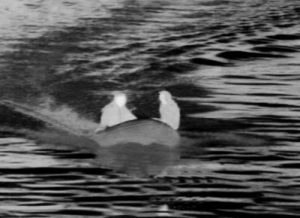
And then, right on cue at 5:34 p.m. Eastern Standard Time, BOB (the Big Orange Ball) disappeared behind us over the watery horizon, and with mostly cloudy skies and a not-too-bright moon, it got really dark really fast. But it was OK – we were mentally prepared, and Smartini has FLIR – Forward-looking Infrared Imaging – so we can kinda-sorta see what’s in front of us, even when it’s pitch black. It’s a narrow field of view, and you can’t see more than a few hundred yards in front of you, but if there was something out there – an unlighted buoy, or boat, or a container that fell off a ship (it happens all the time!) – you can see it. At first, we kept our eyes glued to it, but that was exhausting, so we settled into a “look at it every 30 seconds or so” rythm, and that was easier.
As it turned out, the darkness wasn’t an issue. Neither of us was having any freakiness about it being dark, especially with the FLIR, and our radar, to help ensure we wouldn’t run into anything. What WAS an issue was the wind, which had begun to build late in the afternoon to a steady 20 – 23 knots, and after dark, built to 27 – 32 knots, almost twice what had been forecast. And yes, it had a huge “N” in the direction, coming mostly from the northeast. Combine that with the fact that were in the Gulf Stream, and – well, let’s just say that we very soon got tired of hearing our big, shiny bell ring!
Fran and I both went through the same set of emotions, as we would learn from talking about it the next morning. First, anger at the weather forecaster for getting it so wrong, then increasing fatigue from having to constantly hold onto something and keep a tight core to keep from flopping around like a rag doll. And then, for a brief time, fear. It was rough, and we were tossing around like we’ve not experienced before, and it was unnerving. Fortunately, we both realized that Smartini is an incredibly strong vessel, built to withstand sea conditions way, way worse than we were experiencing, and that although we weren’t going to like it, we didn’t have anything to fear.
Until about 1:30 a.m., when I came back up to the flybridge after an engine room check, and noticed the dinghy sliding forward and backward about a foot with every pitch forward and backward. Another one of the pads had come loose, and the forward ratchet strap with it! Suddenly, we had a potential nightmare scenario on our hands. If we couldn’t secure the dinghy, it would continue to work its way loose from the deck, and we’d have 700 lbs. of boat, motor, and two folding bikes sliding around 10 feet off the water, and eventually, surely, finding their way off the back of the upper deck, dropping onto the swim platform below. A really active imagination might even picture the propeller on the motor puncturing the swim platform, which is part of the hull on Smartini, allowing the ocean to intrude into our normally dry bilge. Clearly, we needed to secure that dinghy!
We have plenty of strong dock lines in storage on the upper deck, but what to tie them to that would be strong enough? Fortunately, I was able to get the forward pad back onto its plate. Sliding around the upper deck on my butt so I didn’t risk becoming a Man Overboard, and always holding on with at least one hand, I got one of the lines fastened to one forward pad, ran it back around the shaft of the outboard motor on the dinghy, and back up to the other forward pad. I tied it off as tightly as I could possibly manage with one hand. Then I put another one around the boom of our crane (the crane that puts the dinghy in and out of the water) and around the dinghy, and made that as tight as possible. Finally, I got both ratchet straps in place, and tightened them as tight as I could. The dinghy now moved less than an inch with each violent pitch of the boat, so as long as it stayed that way, we’d be OK.
While the above episode wasn’t exactly fun for me, I think it was worse for Fran. She was at the helm, with her head swiveling back and forth between the FLIR screen and me, wondering just what the hell she’d do if I lost my grip and went overboard. I had my life vest on, but in the dark, in seas like that, how would she ever find me? The vest has a whistle on it, but with 30 knot winds, I could blow until I was blue in the face and it wouldn’t help her locate me. The vest doesn’t have a strobe on it, nor a PLB (Personal Locator Beacon, a small GPS-equipped transmitter to help locate someone in the water). She decided right then and there that we’d never do another overnight trip without both of those things on our life vests, nor without checking to make sure my life insurance policy was paid up!
(Editor’s note: sorry for the lack of pictures to help illustrate this portion of the story. Cameras were about the last thing on our minds!)
By 2:00 a.m., the faint glow of Miami was visible in the distance. We had finally settled into our reality, getting comfortable with being uncomfortable. I did break our normal routine by not doing any more engine room checks. With that much motion, crawling around next to a giant diesel engine with spinning belts and parts in excess of 700 degrees seemed way more dangerous than simply trusting that everything was OK down there. (It was OK down there – Smartini was mechanically perfect this whole trip, never missing a beat, engine speed never wavering more than a few RPMs, and all temperatures solidly in the green range the whole time.)
At 2:54 a.m., due east of the north end of Key Largo, we made our final turn toward Miami, and within 20 minutes, we must have left the Gulf Stream, because it got noticeably calmer, which makes sense. What doesn’t make sense is that the wind started dying down, too, and by the time we were a few miles off the coast of Miami, was right where it had been forecast – about 17 knots. Was it a function of being closer to shore? Was the forecast right all along, and we were simply east of the zone for which the forecast was made? We’re going to have to learn more about these things, clearly.
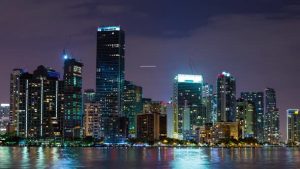
At 3:24 a.m., we entered Government Cut, the huge ship channel leading into Port Everglades. As much as I despise driving in downtown Miami, I never thought I would be happy to see it, but at that moment, it was an absolutely beautiful sight. This photo is a stock photo, but that’s how calm the water was that night. We even had an incoming tide which created a nice following current, and saw 10.6 knots on the display, which is FLYING for Smartini. We had made it!
The rest of the trip was uneventful. Before 7:00 a.m., several of the drawbridges on the ICW (Intracoastal Waterway) in Miami will open on request, so we didn’t even have to slow down for them. We had thought about anchoring somewhere for several hours, but our good friend and longtime business partner Joel’s boat was not tied up at the dock behind his house, and we figured we could get there in time for breakfast, so we puttered along on the nice, smooth water of the ICW until pulling up to his dock a little after 9:00 a.m. He had fresh crepes waiting for us!
We spent the day relaxing with Joel and Jill, then leisurely motored the rest of the way up the ICW to Riviera Beach the next morning, well ahead of our scheduled haul out three days later.
What did we learn from this trip? Several things.
1. You can’t trust the weather forecast, so unless the forecast is for NO WIND and FLAT CALM SEAS, we won’t be doing an overnight. Life’s too short for that kind of stress.
2. We need strobe lights and PLBs on both of our life vests.
3. We need a better way to secure the dinghy. (We just bought a different one yesterday – a 13′ Boston Whaler – and have already planned a much better mounting system for it!)
4. Smartini can handle conditions way worse than we’ll ever want to be out in. We kinda felt that, but now we know it for sure.
5. We need to learn a lot more about how wind and waves are different just short distances offshore.
6. May is officially a boat kitty! Soon after the sun came up on Thursday, she came up on the flybridge with us and acted like the night was no big deal.
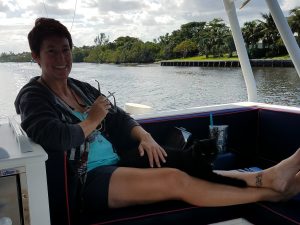
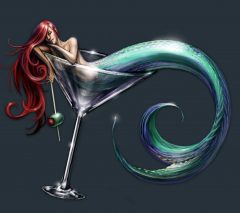
Holy moly! I’m exhausted just reading that. I’m so proud of you guys!
I’m proud only because we didn’t just go below and curl up in a ball, whimpering! (But thanks, Sondra.)
Love the details and account of the trip. Glad things worked out for you and look forward to many more posts!
Thanks, Mike. We’re pretty happy things worked out, too!
I love all the details of your saga. I can picture myself being there with you and I’d have tied one of those lobster trap buoys onto your life vest if I’d have been there! As detail oriented as you both are I cannot believe you didn’t have strobes and PLBs on your life vests. I would also think about when doing repairs in rough seas(let alone at night) having a line secured from you to the boat somehow. It would make Fran’s life easier to either get you back on board or cut you lose!
Bob, Fran spent a couple hours today looking at various PLB’s, strobes, and other lifesaving equipment! She also investigated using lifelines, but the problem is not having a great place to tie to. Sailboats use them all the time, but they’re set up for it. We’ll keep thinking about it, though! BTW, I now think of you every time we go past the pink condo in Marathon – which we did during daylight on this journey!
Wow! That’s sounded intense! Glad you made it okay!
Yes, it was a little higher on the intensity scale than we’re looking for in our old ages! We’ll do our best to not let it happen again.
Cowabunga! What a great adventure! I want to send our GoPro right now and would have loved loved loved some videos captions from your trip! I can’t wait for the next Smartini chapter! I feel like binge watching (reading) more from your blog – glad you are safe and PLEASE enjoy the best of Holiday adventures!!
Tom54
“Great adventure”? Well, I guess that’s about right coming from a man who runs 100 miles for fun! I agree, though – some GoPro video would have added to the story. We’ll have to hook ours up the next time we’re going to – WAIT! We’re NEVER going to do that again!